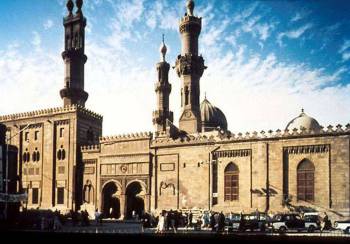 In the Al-Hussein quarter in Islamic Cairo, the historic Mosque and University of A-Azhar stands welcoming worshippers, students and visitors.
In the Al-Hussein quarter in Islamic Cairo, the historic Mosque and University of A-Azhar stands welcoming worshippers, students and visitors.
The mosque, like other Islamic monuments located in heavily populated areas in Cairo, was suffering from environmental factors including air pollution, a high subsoil water level, a high level of humidity, leakage from the al-madiaa (a fountain used for ritual ablution), out-of-date sewerage systems and the adverse effects of the 1992 earthquake.
The prestigious Mosque-University of Al-Azhar was built upon the orders of the Fatimid caliph Al-Muizz Li-Din Allah by architect Gawhar Al-Seqeli, who built the then Fatimid Empire’s new capital of Al-Qahera (the Triumphant), today the heart of Islamic Cairo.
This soon became a place of opulent palaces, mosques, madrassas (schools) and sabils (water fountains).
Al-Azhar was named after the Prophet Mohamed’s daughter Fatma Al-Zahraa. It was the first Fatimid monument to be built in Egypt and was a meeting place for Shia students, becoming the focal point of a famous university.
The architectural style of the mosque shows the influence of the various dynasties and their characteristic contributions over subsequent centuries.
Today, Al-Azhar, which covers an area of 12,000 square metres, is double its original size and shows various Islamic architectural styles, including in a succession of riwaqs (arcades), madrassas, mihrabs (pulpits) and minarets.
These were added to what was originally a courtyard surrounded by three arcades, of which the widest runs along the qibla (prayer niche) wall.
The mosque was renovated and expanded several times during the Fatimid era, but during the subsequent Ayyubid period it was neglected because it represented a Shia, and not a Sunni, regime.
The Sunni Ayyubids introduced the Sunni doctrine to the mosque and its teaching of Islamic jurisprudence, even as Al-Azhar continued to serve as a centre for Arabic language and education.
Mohamed Abdel-Latif, assistant to the minister of antiquities for Islamic antiquities, said that the Egyptian Mameluke regime, which ruled Egypt after the fall of the Ayyubids, had restored the mosque, especially during the reign of the Mameluke sultan Baybars.
A madrassa was built along the northwestern wall and a portion of the old wall removed to accommodate the new structure.
Another madrassa was also provided neighbouring the first, as well as a new ablutions fountain for the main mosque, and prayer halls were constructed for Al-Azhar’s schools and other annexes.
The Mameluke sultan Qansur Al-Ghouri later built the two-headed minaret that is the tallest of all Al-Azhar’s minarets and a superb example of Mameluke architecture.
After the fall of the Mamelukes with the Ottoman invasion in 1517, the Ottoman rulers of Egypt created several waqfs (religious endowments) to fund the construction and upkeep of the Al-Hanafiya riwaq, the Turkish riwaq, the Suleimaniya riwaq, the Al-Sham riwaq and the Amyan prayer hall at Al-Azhar.
The greatest extension of the mosque, said Abdel-Latif, began under the Mameluke emir Abdel-Rahman Katkhuda when a dome was constructed and the Bab Al-Muzayini (Barbers Gate), which now serves as the main entrance to the mosque, was built.
Renovations and repairs were also made under Mohamed Ali Pasha in the early 19th century and his successors. Under the khedive Abbas Helmi II in the late 19th century a new library was built, as well as the largest of the mosque’s riwaqs.
Al-Azhar today remains a deeply influential institution in Egyptian society and is highly revered in the Sunni Muslim world as a symbol of Islamic learning and culture.
Source: Al-Azhar Mosque shines after years-long restoration – Politics – Egypt – Ahram Online
Categories: Africa, Arab World, archaeology, Archeology, Egypt, North Africa
